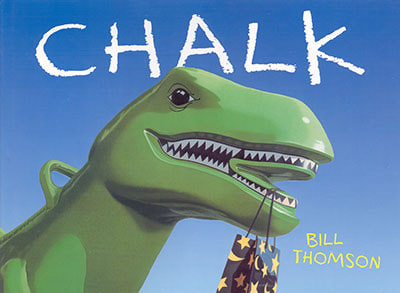 by Bill Thomson
by Bill Thomson
Wordless. Children find magical chalk with which everything they draw becomes real and abundant.
Strategies/Skills Used
Reading Strategy 5: Make mental pictures.
Reading Strategy 12: Reflect and respond.
Writing Skill 7: I use my personal style to make my writing unique.
 TEACHING THE ACTIVITY: PRE-READING
TEACHING THE ACTIVITY: PRE-READING
(1) Explain, “Today we will be making our voices come alive as we ‘read’ a wordless book.” Follow Step 1 of Words for Wordless by reading the book title and showing the front and back covers to the class.
(2) Have students predict what they think the book will be about based on the title and covers.
 TEACHING THE ACTIVITY: DURING READING
TEACHING THE ACTIVITY: DURING READING
(3) Show “chunks” of the story, stopping at logical points to enable students to develop possible words to tell the story. To guide these discussions, you could have the class consider what the characters might say or think, as well as the narrator’s words.
(4) At each stopping point, hold the book so that only the students (not you) can see the illustrations. Explain, “Because I can’t see the pictures, you’ll have to be very descriptive to help me understand what’s happening. Make me feel like I’m in the middle of the story.” If you determine details are missing (because you know the storyline, of course), ask probing questions to draw students’ attention to illustrations’ details. Explain how knowing as many details about the illustrations as possible helps you choose which words you will use to retell the story.
(5) Show students how you can use the details and “voices” they provide to retell the story.
 TEACHING THE ACTIVITY: POST-READING
TEACHING THE ACTIVITY: POST-READING
(6) Reflect on what it was like to add words to a wordless book. Possible discussion questions might include:
- Do you feel our retelling told the story effectively? Why or why not?
- Did you think of any words/dialogue I didn’t include in my retelling?
- Did you like the story more as a wordless story, or a wordy story? Why?
(7) Tell students they are going to bring the story to life even more. Have them break into groups to come up with Sound Effects to go along with the retelling of the story.
(8) Retell the story and have each group of students add their sound effects throughout the retelling.
TEACHING THE ACTIVITY: POST-READING EXTENSION
(9) Give students sidewalk chalk and have them draw one aspect of the story (a character or portion of setting). Place students into groups, and have them include each member’s story aspect into a story of their own crafting. Provide an opportunity for students to share stories and reflect on similarities and differences in the storyline and voice used to tell the story.